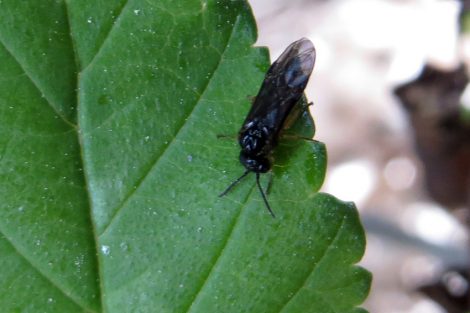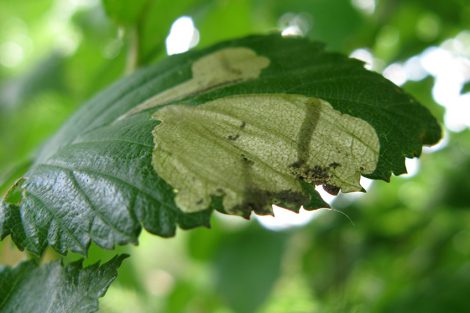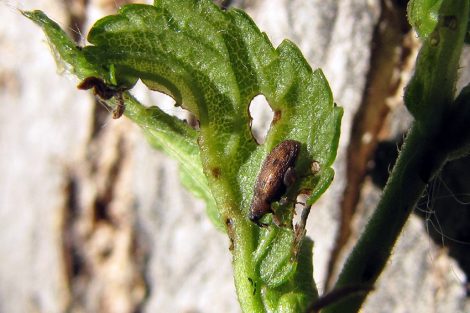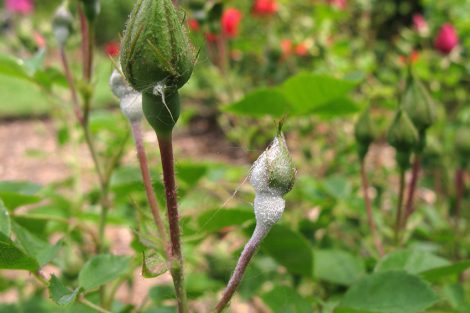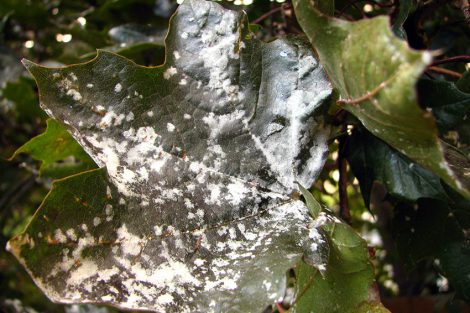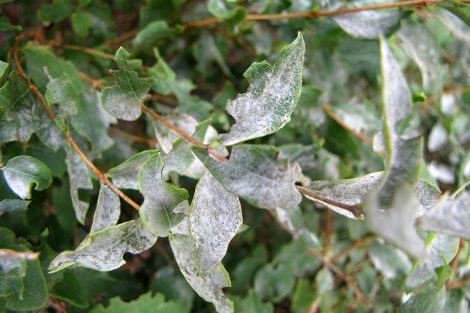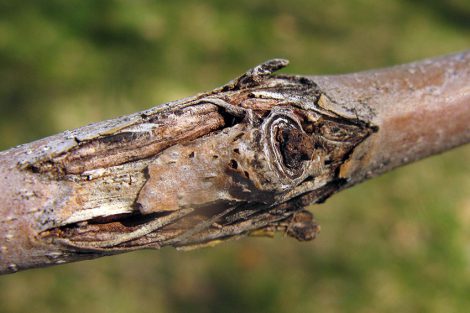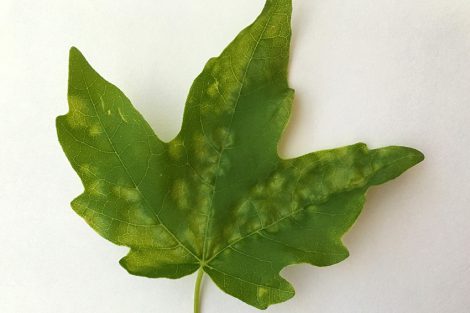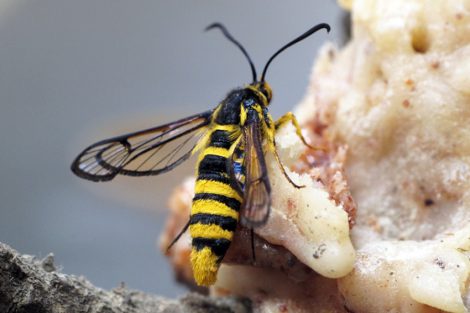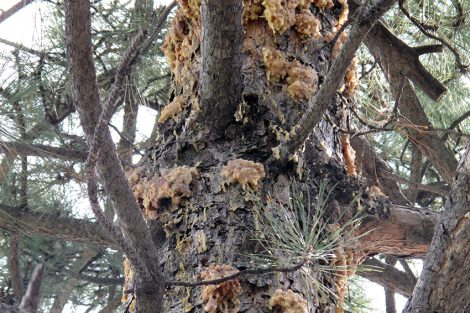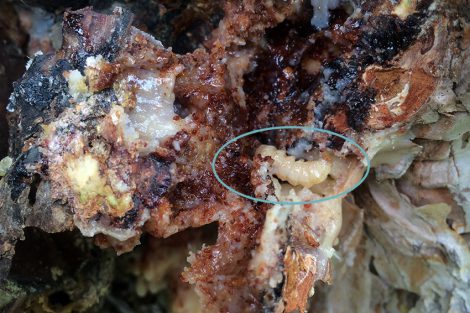In this Issue:
- Lilac-ash borer: Treat susceptible tree trunks starting now (Wasatch Front) through mid-July
- Elm insects: Elm leafminer and elm flea weevil active now
- Bronze birch borer: Adults start emerging (Wasatch Front) May 23
- Powdery mildew: Monitor plants for white mycelium
- Anthracnose: Infections on sycamore and maple may be occurring with the rains
- Pine pitch mass borer: Apply trunk spray now
- European pine sawfly: Sawfly larvae feeding now; not a pest of concern
DECIDUOUS TREES
Lilac-Ash Borer
Treat susceptible trunks monthly, starting now, until mid-July
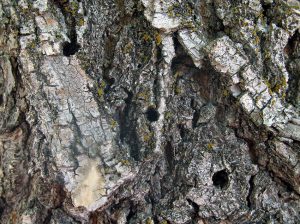
Lilac-ash borer adults are just starting to emerge from infested trees along the Wasatch Front, and in one to two weeks in cooler areas.
Females lay eggs on the bark of ash trees and lilac. Green and white ash (Fraxinus) are the most susceptible. Sometimes, mountain-ash (Sorbus) and privet are attacked.
Lilac-ash borer does not directly kill trees, but repeated infestations can cause branch dieback and can leave trees susceptible to breakage in storms. Infested trees will have round exit holes on the bark, sawdust-like frass near the holes or at the base of the tree, and rough, swollen, cracked bark, mostly near branch crotches.
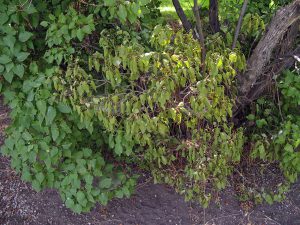
Treatment:
Healthy plants are able to withstand minor infestations, while stressed plants are more susceptible to attack and failure, so give trees optimal water and fertilizer, and prune properly.
Insecticides target the adults. Small trees can be treated by the home gardener, but in order to get thorough coverage on large trees, treatments should be made by a licensed pesticide applicator.
Applications should protect the bark for 6 weeks (usually until mid-July), so repeat as needed.
- Residential options: Hi-Yield Permethrin, Spectracide Triazicide (lambda-cyhalothrin); spray trunks once/month
- Commercial options: Acelepryn (chlorantraniliprole), permethrin (Astro, Covert, Waylay), or bifenthrin (Onyx)
Elm Insects: Flea Weevil and Leafminer
If issues in the past, treat trees now
Siberian elm is not our favorite tree, but still, it is good to know about two of the (many) pests that are active now.
The elm flea weevil is a tiny insect that often goes unnoticed. It overwinters as an adult, and starts feeding on newly emerging foliage. It hides on the undersides of leaves, chewing tiny holes. Females lay eggs along the leaf veins, and the larvae mine the inside of the leaves for several weeks. The adults are around through mid to late summer.
Elm leafminer is a sawfly whose feeding will be noticed soon. The larvae feed within the leaves, between the upper and lower layers. If several larvae are mining one leaf, their mines will coalesce, leaving the entire leaf brown and hollowed-out. The full-grown larvae emerge from the leaf and drop to the ground where they remain until the following spring, when they then pupate to an adult.
Treatment:
Insecticides are rarely needed, but if applied, should target the adults of both species.
Bronze Birch Borer
Treat trunks by May 23, and repeat once or twice every 2-4 weeks
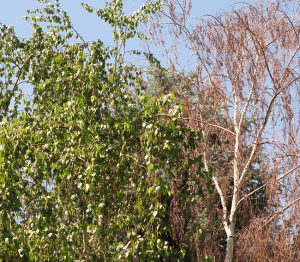
Treatment:
- Residential: Keep trees healthy with optimal water and nutrients (including iron). We recommend hiring a commercial applicator that can reach all parts of a tall tree. Otherwise, use a Hi Yield permethrin product or Sevin.
- Commercial: Imidacloprid can be used as a soil drench, but ideally should be applied in early spring, as the tree needs time for uptake. Studies have shown, however, that soil applications applied in late spring will also kill a certain amount of larvae within the tree. Trunk sprays include permethrin, bifenthrin, or carbaryl.
Honeylocust Borer
If positively identified, treat trees now
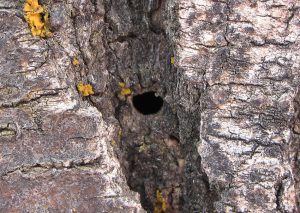
Honeylocust is a widely planted tree that we typically don’t think of as having problems with borers. But in the last few years, trees in the Salt Lake area have been found infested with honeylocust borer (Agrilus difficilus).
Honeylocust borer is a flatheaded (metallic) beetle related to the pacific flatheaded borer, bronze birch borer, and emerald ash borer (which is not in Utah). It only attacks honeylocust, and is not to be confused with the locust borer that only attacks black locust.
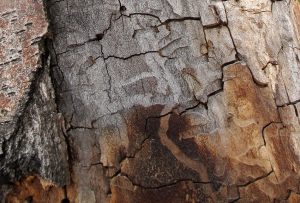
Trees that are under drought stress, or newly planted trees, are the most susceptible. Mature, healthy, and properly planted trees are rarely attacked.
Adults start laying eggs on the bark in May, and continue for 6 weeks.
Larvae bore into the tree’s cambium where they create shallow, meandering tunnels. Tree sap will ooze out of the entry site and then harden into a frothy mass of gum. Repeated infestations gradually cause decline and dieback of twigs and branches in the crown.
Treatment:
Management relies on prevention. Keep trees healthy with optimal watering and fertilizer so they can withstand attack.
Insecticides should target the adults. Although the larvae of flatheaded borers can be killed by systemics, they should not be used on honeylocusts, as these trees are bee-magnets when in bloom.
- Residential options: Hi-Yield Permethrin, Spectracide Triazicide (lambda-cyhalothrin)
- Commercial options: Acelepryn (chlorantraniliprole), permethrin (Astro, Covert, Waylay), Onyx (bifenthrin)
Powdery Mildew of Ornamentals
Treat foliage as necessary
As the temperatures warm, powdery mildew will start to show up on many ornamental plants. Be sure to scout early and often to catch this disease before it gets too bad.
Treatment:
- Residential: Avoid overhead irrigation, improve air circulation between plants, and rake fallen leaves in the fall. Fungicides include horticultural oil (0.5%), potassium bicarbonate (Bicarb), Bayer Advanced Natria, neem oil, Spectracide Immunox, or chlorothalonil. The fungicide must be applied as a preventive to stop future infections.
- Commercial: There are many fungicides, including sulfur products, Banner Maxx, Bayleton, Eagle, Heritage, PropiMax, and more
Anthracnose of Sycamore, Maple, and Oak
Plan to treat foliage between rains
Anthracnose is a fungal-caused disease that thrives in cool, wet weather. It causes blotch and blight symptoms on leaf shoots, which appear as necrotic (brown) lesions that eventually cover the entire leaf. Leaves that are infected in early spring will drop, and new infections may occur with additional cool, wet weather.
When temperatures increase later in the season, anthracnose will become inactive, and infections will stop for the season. In addition, the tree will produce a new flush of healthy foliage.
Maple and oak anthracnose overwinter in fallen leaves, so these diseases are the most severe in natural or wooded areas where the fallen leaves collect from year to year.
Sycamore anthracnose is more insidious because the disease is “systemic,” in that it invades the wood of twigs, causing small cankers. The fungus overwinters as resting spores at these cankers, and as a result, infections can happen every spring.
Treatment:
- Maple and oak anthracnose are treated by preventive fungicides applied at budbreak in spring. However, with continued cool wet weather, an application now could help prevent further spread.
- For sycamore anthracnose, prune out dead or diseased twigs. For specimen trees, fungicide trunk injections (Arborfos, Arbotect) in spring or fall, for 2 years in a row, have shown to provide long-term protection.
CONIFERS
Pine Pitch Mass Borer
Treat trunks of pines now
The Sequoia pitch moth (Synanthedon sequoiae) is a clearwing moth whose larvae feed on the outer and inner bark of pine trees. Their feeding stimulates the tree to produce copious sap that forms large, drippy masses on the trunk. The larvae will also feed within the mass of pitch and if you remove the glob at the right time, you will often find a larva inside or close to the trunk.
From May through August, adult moths lay eggs on bark, often preferring pruning or other wounds, branch collars, or existing pitch masses. When the eggs hatch, the larvae bore through the bark and create meandering tunnels in the cambium, or may bore into the sapwood. The feeding is usually localized around the pitch mass, and sometimes, the larvae will exit the wood and feed on the pitch.
Smaller trees are at greatest risk of being affected by pitch mass borers. Larger, healthy trees can withstand attack.
Keep in mind that after the moths exit the trees, the pitch mass will remain on the trunk, possibly for several years, unless they are removed by hand.
Treatment:
Management should focus on keeping trees healthy. Avoid pruning in July when moths are laying eggs. Manually remove existing pitch masses to prevent further egg-laying or to kill larvae inside. If a spray is warranted on larger trees, it should be applied by a professional.
- Commercial: permethrin or bifenthrin (trunk sprays); start application in early to mid May, so that trunks are protected through early August
European Pine Sawfly
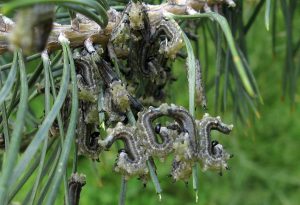
Larvae of the European pine sawfly are now feeding on last year’s needles of mugo, Scotch, Austrian, and ponderosa pines. In large infestations, they will leave behind bare branches but thankfully, do not feed on the current season’s buds. As a result, the new needles will often hide the damage.
Sawflies are not caterpillars. They are related to ants, bees, and wasps. They overwinter as eggs laid in slits along the length of needles. The larvae feed for about 4 to 6 weeks. They then pupate, and adults emerge in the fall to mate and lay eggs.
Initial damage looks like brown wilted foliage because the larvae are only feeding on the margins of the needles. As larvae mature, they group together and gorge on entire needles, sometimes causing complete defoliation. When attacked or harassed, the larvae rear back their heads in defense, and are able to eject a repellent substance from a sac off the foregut.
Treatment:
- Treatment is rarely needed, as feeding is localized and usually not severe enough to harm the plant. Because they feed together, removing a branch removes most of the larvae; hand-picking is another option.
- If necessary, spray options include acetamiprid (Tristar, Ortho Flower, Fruit, and Vegetable Insect Killer) azadirachtin (Safer BioNeem, Safer Grub Killer), spinosad (Conserve, Fertilome / Monterey), horticultural oil, or insecticidal soap. Bt does not work on sawflies.

